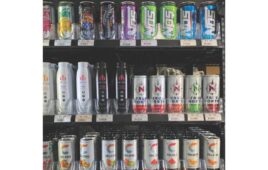 Loyal moist tobacco dippers overwhelmingly command the smokeless segment, but consumers are eagerly trying non-tobacco spitless pouches, which are driving sales with impressive double-digit growth as retailers consider expanding their offerings.
Loyal moist tobacco dippers overwhelmingly command the smokeless segment, but consumers are eagerly trying non-tobacco spitless pouches, which are driving sales with impressive double-digit growth as retailers consider expanding their offerings.
While moist smokeless tobacco (MST) like loose snuff and pouches dominate in convenience stores with more than 80% of the segment, according to data from IRI Worldwide, non-tobacco modern oral nicotine has been on a tear. Convenience channel dollar sales of modern oral nicotine spitless products for the year ending Feb. 20, 2022, skyrocketed by 39.7%, according to IRI. And retailers are taking notice.
“Within our business model, we really took on a big investment with modern nicotine like the ZYN, On!, Velo and Rogue,” noted Jon Manuyag, director of marketing with Beaverton, Ore.-based Plaid Pantry, which operates 107 stores in the Pacific Northwest. “(We) have found some huge success over the last two years within this category, and it continues to still grow.”
Michelle Signorelli, tobacco category manager for Atlanta-based RaceTrac’s 560 stores throughout the southeastern U.S., has found that the non-tobacco spitless products are showing plenty of appeal to more traditional dippers, as well.
“We’re getting a lot of trial from that,” said Signorelli. “I don’t have the ability to see complete conversion consumer to consumer, but I haven’t seen cannibalization into MST. It’s more so just been poly use of (customers) buying them together.”
But while both Signorelli and Manuyag have seen a lot of moist users sampling modern nicotine products, that hasn’t been the case for central Texas, according to General Manager and Retail Director Vince Segura of Fuel City, which operates seven c-store locations in the Dallas-Ft. Worth metroplex. In his area, traditional tobacco’s rule over the back bar hasn’t been challenged by modern oral nicotine.
“They move, but not at a rate that you would expect them to,” said Segura. “Moist snuff definitely does. … Copenhagen primarily is No. 1, followed probably by Grizzly for our customer base here.”
Segura calls Fuel City’s smokeless consumer ‘a specific type of customer.’ Brand loyalty is important to those folks. “If I’m a Copenhagen guy, I’m not going to go try a Velo or ZYN or a snus to replace it,” he added.
 Merchandising Considerations
Merchandising Considerations
Spitless dollar sales growth decreased slightly for the 12 weeks and four weeks ending Feb. 22, slowing to 31.7% and 32.6%, respectively, but that matches the smokeless category as a whole, which saw growth ease 0.7% and 3.1% for the same periods.
For RaceTrac, moist snuff growth has been soft, according to Signorelli, which she attributed to consumers having fewer usage opportunities as the pandemic eases and more of the workforce returns to the office or jobsite.
“We saw the normal January decline, which wasn’t unusual — it always happens at that time,” explained Signorelli. The drop in sales growth in November and December caught retailers like her by surprise. “That’s actually typically a lot higher of a time for MST.”
Retailers don’t seem to be seeing much movement with nicotine lozenges or toothpicks. Fuel City no longer carries either. Both RaceTrac and Plaid Pantry stock the lozenges, but sales aren’t very robust at either chain.
RaceTrac’s Signorelli wonders whether these products need to move off the back bar, away from more traditional nicotine products. “My question mark’s still up in the air on if that needs to be something a little bit more shoppable. … So I wonder if that will emerge into a health and beauty aid (HBA) realm, similar to grocery,” she said.
As for merchandising the smokeless category, more manufacturer-based promotions may be in the cards. Convenience vendors across all categories may have been shy running specials with uncertainty brought about by recent supply disruption.
“A lot of them have a lot of promotions starting back up now that they have a little bit more confidence in their inventory,” Signorelli said.
At Plaid Pantry, Manuyag said he’s been able to get “crafty” with promotions. The chain is currently running a ‘buy three and save $4,’ which has consumers purchasing six tins to save $8 in lieu of buying a full roll.
As for regulation, the spitless category has largely avoided scrutiny. But that could change.
“I think a lot of us are just waiting to hear on the regulatory front — whether it’s cigars or vapor and now the tobacco-derived nicotine — how that shakes out before everybody buys into a ton of products that could potentially be taken off the market,” said Signorelli.




